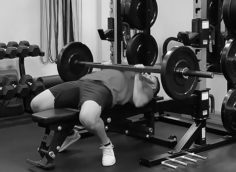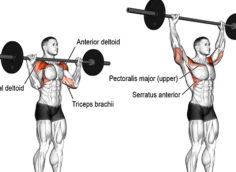Here's what you need to know...
- If you train legs with biceps, the biceps grow faster. The leg training causes an increase in testosterone and GH production.
- Training the legs before other smaller body parts works equally well. For instance, the triceps grow faster when paired with leg training.
- In general, do multi-joint exercises like squats and deadlifts early in a training session. This method produces more testosterone.
- Do exercises that produce lactic acid later on in a training session. They cause growth hormone to be produced.
- Leg training should be split in two to take full advantage of the hormonal surge. Quads and triceps should be trained on one day and hamstrings and biceps should be trained on another.
Leg Training and Hormones
Leg training is painful, if you're doing it right. But intensely training your legs also does something amazing: in causes a natural surge in testosterone and growth hormone.
Already a T Nation+ Member? Log in
You haven’t completed your membership signup
Your T Nation+ membership has expired
Get instant access to this content
Become a T Nation+ member and get immediate access to all of our member-only videos, articles, coaching groups and more.
Click here to learn more about T Nation+Click here to complete the signup processClick here to renew your membership
You may have already known that, but you may not have thought of this next part. What if you train your legs, get that hormone boost, and THEN train a smaller muscle group, like your biceps or triceps? Wouldn't it make sense that you'd get better arm growth due to the elevated levels of GH and testosterone?
Luckily, we don't have to theorize. A group of researchers at Lillehammer University College have figured out how to put those leg-training induced hormones to work for you.
The Science
The researchers recruited 9 males between the ages of 20 and 34 and had them follow a bodybuilding style program for 11 weeks. Two days a week, they trained only their left biceps with curls, hammer curls, and reverse curls.
On two additional days per week, they trained their legs with leg presses, leg extensions, and leg curls, followed by a training session for the right biceps, using the same exercises previously performed for the left biceps.
After 11 weeks, the right biceps, which had been trained during the same session as legs, was significantly bigger and stronger than the left biceps. The researchers found higher levels of GH and testosterone during leg plus arm-training sessions and concluded that they were responsible for the additional growth and strength in the right arm.
You can benefit from this research by adopting an innovative training split that takes advantage of this relationship between legs and arms.
The Program
So, leg training, because it's so damn taxing, causes a cascade of biochemical processes that lead to an increase in GH and testosterone. You can take advantage of this concept by training legs and biceps, or presumably any smaller body part (e.g., triceps), on the same day. However, you can take this information even further by building your whole routine around it.
Split Your Leg Training Up
Most people work legs once, maybe twice a week, and then pull the covers over their head until it's time to, groan, work legs again because it's scary and painful, but even beyond that, there's a problem associated with training legs.
Leg training is comprised of quad dominant movements and hip dominant movements. You could more easily (but not as precisely) call this quad training and hamstring training. However, rarely do both groups of muscles get trained adequately. You either give the quad dominant movements the big piece of chicken at the dinner table or you give it to the hip dominant movements.
Given the size of these muscles, it's just ordinarily impossible for most non-cape wearing mortals to work both groups equally well in the same workout. One muscle group ends up suffering and sulking, starving for attention and adequate stimulation.
It's therefore smarter to break leg training into two separate workouts, and in doing so employ the testosterone-boosting method discovered by the researchers with two body parts instead of one:
- Pair the quad dominant workout with triceps.
- Pair the hip dominant workout with biceps.
You get the muscle-building advantage of breaking the legs into two groups and devoting more sweat and effort to each, and you confer the testosterone/GH benefits to the triceps and biceps.
The other workouts in the training week or split can then be devoted to the larger muscle groups of the upper body (chest, shoulders, back).
Fine Tuning Testosterone and GH Production
Clearly, large compound exercises like squats and deadlifts and their variants produce more testosterone than smaller, less challenging moves.
GH, however, is spurred largely by protocols that elicit lactic acid. This generally means protocols that are relatively high in intensity (about 75% of 1RM), high volume, and with short or shorter rest periods.
While the testosterone-inducing exercises or protocols should be done early in the workout, the GH spurring movements can be done later, or last, in the training session. Doing both types of training prepares the right hormonal stew in which the biceps and triceps can simmer and grow.

The Testosterone Advantage Template
To take advantage of the findings of the researchers and other studies on testosterone and GH, we want a program that does the following:
- Splits leg training into quad dominant and hip dominant days.
- Pairs triceps training with quad dominant exercises and pairs biceps with hip dominant exercises.
- Employs large muscle mass, multi-joint exercises done with heavy weight for low reps (3 to 8) early in the workout to elicit further production of testosterone.
- Employs high volume protocols with short rest later on, or last, in the workout to elicit further production of GH.
Below is how this might look. Bear in mind that I've only laid out how you might train quads/triceps and hams/biceps. I've left out specific training suggestions for chest, back, shoulders, etc. because the testosterone/GH findings probably wouldn't work if you paired a big body part like chest or back with leg training.
Training legs properly, i.e., busting a nut, probably wouldn't leave you with enough mojo to properly train another big body part. It's like training quads and hams together in that one of the two gets the short end of the stick. Even with all that extra leg-training induced testosterone and GH, it still might not be enough to push the muscle meter to the plus side.
Feel free, though, to use the general testosterone and GH promoting protocols (heavy weights for low reps and high-lactic acid producing exercises) with chest, back, and shoulders.
The Split
- Day 1: Quad Dominant Leg Training + Triceps
- Day 2: Chest and Shoulders
- Day 3: Off
- Day 4: Hip Dominant Leg Training + Biceps
- Day 5: Back and Ancillary Muscle Groups
Day 1: Quad Dominant Leg Training + Triceps
A. Quad Dominant Workout
Examples of testosterone-elevating quad-dominant movements (done with heavy weight for low reps and multiple sets, e.g. 4 sets of 6):
- Squat
- Hack Squat
- Bulgarian Squat
- Leg Press
Examples of GH-elevating quad-dominant movements (generally done with about 75% of 1RM that employ exhaustion-inducing protocols) to be done after testosterone-elevating movements like those mentioned above:
- Smith Machine Squat, using one and a quarter reps
- Leg Extension, using drop sets
- Leg Press, sets of 8-10 reps, with rest periods of 30 to 45 seconds
B. Triceps Workout
Examples of triceps movements (the first triceps exercise should use heavier weights done for fewer reps, 6 to 10, while subsequent exercises should use higher rep ranges, 10 -15, to target multiple fiber types:
- Close-Grip Bench Press
- Skull Crusher
- Cable Pushdown
- Kettlebell Kickback
Day 2: Chest and Shoulders
Day 3: Off
Day 4: Hip Dominant Leg Training + Biceps
A. Hip Dominant Workout
Examples of testosterone-elevating hip-dominant movements (done with heavy weight for low reps and multiple sets, e.g. 4 sets of 6):
- Deadlift
- Stiff-Leg Deadlift
- Hip Thrust
- Hang Snatch
- Power Clean
- Glute/Ham Raise
Examples of GH-elevating hip-dominant movements (done with about 75% of 1RM that employ exhausting-inducing protocols), to be done after the testosterone-elevating movements above:
- Lying leg curl, using drop sets
- Romanian Deadlift, using one a quarter reps with 30 to 45 second rest periods
- Kettlebell Swing, doing 6 reps with one arm, resting 15 seconds, and then doing 6 reps with the other arm and then resting for 15 seconds. Continue in this manner for 10 minutes.
B. Biceps Workout
Examples of biceps movements (the first biceps exercise should use heavier weights done for fewer reps, 6 to 10, while subsequent exercises should use higher rep ranges, 10-15, to target multiple fiber types):
- Barbell Biceps Curl
- Dumbbell Biceps Curl
- Seated Incline Dumbbell Curl
- Hammer Curl
- Cable Curl
Day 5: Back and Ancillary Muscle Groups (Abs, Calves, Rotator Cuffs)
This template is only a suggestion and you may decide to flush it down the vortex of the training toilet. Fine, but you should at least try pairing leg training with biceps and/or triceps in general to see how the additional hormonal surge works for you.
Source
- Ronnestad BR1, Nygaard H, Raastad T. "Physiological elevation of endogenous hormones results in superior strength training adaptation, " Eur J Appl Physiol. 2011 Sep;111(9):2249-59.





